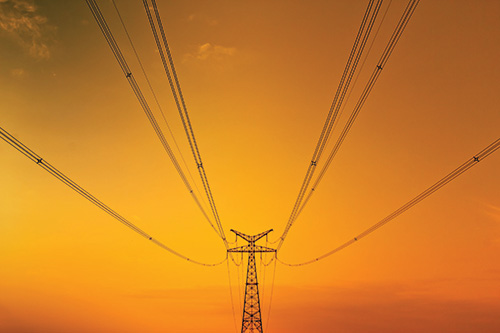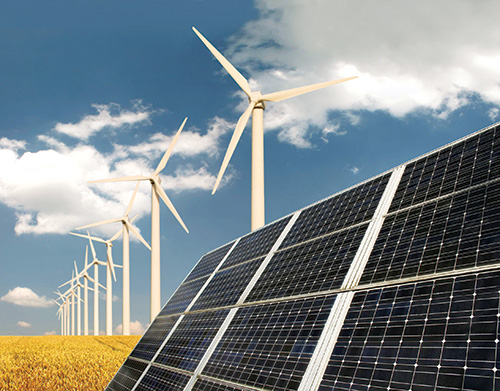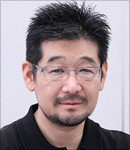In a time driven by the adoption of renewable energy resources, we’re also experiencing new challenges with the way that power is supplied. Electric utilities and grid operators are tasked with integrating distributed energy into the mix without compromising the steady flow of the electric power that we need. Any interruption is an inconvenience. Utilities recognize this, but they also acknowledge the need for change within the commercial distribution of electrical power. In fact, the U.S. Energy Information Administration estimates1 that national electricity transmission and distribution loses an average of 6 percent of the electricity annually from being transmitted and distributed throughout the U.S. With the rise of renewable energy sources – accounting for at least 19.5 percent of global electricity2 – we must find a way to integrate these renewables into our T&D systems as soon as possible.

But first we must ask...what is the real potential of renewables in electric energy?
The Department of Energy was formed in the 70s, and the organization immediately put the Natural Gas Policy Act3 into place. But, today’s need for renewable energy is different than it was at that time. The current resurgence of renewable energy stems from the need to reduce the high environmental impact that we’ve put on our grids over the last few decades. The environment is affected by the major sources of pollution which originate from coal-fired plants that release gases into the air.4 Numerous policy acts have been put into place, but we need to a find a solution to replace the continuous need to build such plants. Today’s energy systems demand efficiency, reliability, and security – and the integration of renewables into our electric grid must support those needs.
Renewables are already saving time and cost for utilities. For example, in 2013, Idaho Power Company (IPC) received a $94 million grant from the U.S. Department of Energy to modernize the grid, including the development of renewable energy integration tools. As part of the grant, IPC was able to improve its forecasting, using 15 percent of natural gas-fired reserves instead of 100 percent. This alone resulted in savings of approximately $50,000 for the utility and its customers, and IPC is seeing similar results on a consistent basis.5
Previous challenges of using renewables in electric power
To be clear, renewables have not always been efficient, reliable, and secure. For example, basic weather conditions have often hampered the ability to collect this energy. This is not surprising if we consider the fact that the three most important things used for renewable energy are the sun, the wind, and rain. All of these elements provide energy, but they also create challenges for the utilities. Farms and ranches are great locations for wind turbines, but these remote areas make it difficult for transmission lines to reach, creating long lines with a high potential for energy loss. There are also the more simple challenges, such as regions that have a very dark winter where the solar panels are untouched by the sun.
Another challenge is the injection of reactive power into the electric grid from outside power sources, such as solar energy. The utility controls the voltage levels of its system, and injects energy into the grid when necessary to smooth out the natural swings in usage and keep the voltage at an acceptable level. But by renewable energies being injected into the grid, it can throw off a utility’s synchronous generator, making it so they can’t track where the power is coming from.
Today’s electric grid can overcome these challenges
These types of challenges are being overcome, however. The electric utility industry has plans to invest $1.5-2 trillion in infrastructure by 2030 to support renewables in the system.6 In the U.S., this initiative is connected to the belief that ‘distributed energy offers solutions to many of the nation’s most pressing energy and electric power problems, including blackouts, brownouts, energy security concerns, power quality issues, tighter emissions standards, transmission bottlenecks and the desire for greater control over energy costs.’7

In order to incorporate renewable energies into their existing infrastructures, companies must address several primary issues that can make the system unstable:
Voltage management: This is especially important to control, and companies are looking to options such as Secondary and Tertiary Voltage Regulators; reactive power compensators such as the STATCOM (Static Synchronous Compensator); battery systems for storing energy reserves; and pole transformers for remote tap control.
Frequency control: A power system often has inconsistent frequencies when adding renewable energy. Companies are searching for solutions that can adjust frequency variations within a specified range by using a faster regulated response.
Controlling output fluctuations: Absorbing excess energy in cases of excessive output fluctuations will help companies maintain a smooth power curve.
Managing electric vehicle charging: This is an increasingly complex problem as electric vehicles become more widely adopted, as rapid charging can cause a sudden increase in load to the system. Batteries can be used to store excess power, minimizing the negative effects of rapid charging on the grid.
Demand response: This is one of the more commonly known solutions for managing energy, and is increasingly being applied to renewables as well. DR allows for the system to automatically request that users suppress power consumption during peak hours, and can automatically shift any surplus power load to a later time.
As more and more companies begin using these types of tools, the entire industry is getting closer to the promise of renewables in the grid.
Technology and policy will move the industry forward
It is reported that 30 U.S. states and the District of Columbia are currently implementing Renewable Portfolio Standards that mandate a certain percentage of electricity generated by a particular technology, such as solar or biomass.8 These types of laws and standards, plus technologies that enable the collection, transmission and distribution of renewables, are driving the global electric energy ecosystem into a much healthier place.
About the Author
 Takafumi Arai is the digital marketing supervisor for Toshiba’s global smart community projects, which include a variety of renewable energy solutions that the company is implementing and testing in a dozen countries. Follow the community at www.toshiba-smartcommunity.com/EN.
Takafumi Arai is the digital marketing supervisor for Toshiba’s global smart community projects, which include a variety of renewable energy solutions that the company is implementing and testing in a dozen countries. Follow the community at www.toshiba-smartcommunity.com/EN.
References
1 “FAQ: How much electricity is lost in transmission and distribution in the United States?” U.S. Energy Information Administration. http://www.eia.gov/tools/faqs
2 “FAQ: Renewable Energy.” International Energy Agency. http://wwwiea.org/aboutus/faqs/renewableenergy/.
3 “Natural Gas Policy of 1978.” U.S. Energy Information Administration. http://www.eia.gov/oil_gas/natural_gas/analysis_publications/ngmajorle/ngact1978.html
4 Department of Energy and National Energy Technology Laboratory. “Environmental Impacts of Smart Grid.” http://www.netl.doe.gov/File%20LibraryResearch/Energy%20Analysis/Publications/Envimpact_SmartGrid.pdf
5 U.S. Department of Energy. “Smart Grid Savings and Grid Integration of Renewables in Idaho.” http://energy.gov/sites/prod/files/2013/06/f1/IdahoPowerCaseStudy.pdf
6 Chupka, M.W., Earle, R., Fox-Penner P., and Hledik R. “Transforming America’s Power Industry: The Investment Challenge 2010-2030.” The Edison Foundation, November 2008. http://www.eei.org/ourissues/finance/Documents/Transforming_Americas_Power_Industry_Exec_Summary.pdf
7 “Distributed Energy.” Office of Electricity Delivery & Energy Reliability. http://energy.gov/oe/technology:development/smart-grid/distributed-energy
8 “Most states have Renewable Portfolio Standards.” U.S. Energy Information Administration, February 3, 2012. http://www.eia.gov/todayinenergy/detail.cfm?id=4850







